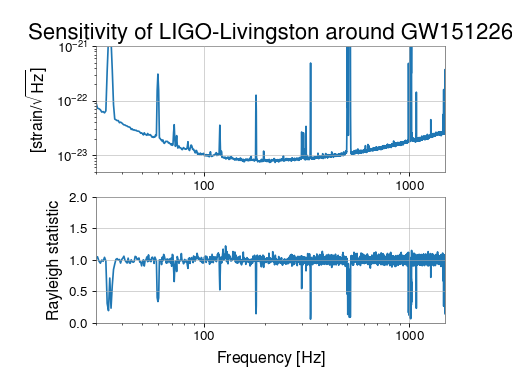6. Plotting a Rayleigh-statistic Spectrum¶
In LIGO the ‘Rayleigh’ statistic is a calculation of the coefficient of variation of the power spectral density (PSD) of a given set of data. It is used to measure the ‘Gaussianity’ of those data, where a value of 1 indicates Gaussian behaviour, less than 1 indicates coherent variations, and greater than 1 indicates incoherent variation. It is a useful measure of the quality of the strain data being generated and recorded at a LIGO site.
To demonstate this, we can load some data from the LIGO Livingston intereferometer around the time of the GW151226 gravitational wave detection:
from gwpy.timeseries import TimeSeries
gwdata = TimeSeries.fetch_open_data('L1', 'Dec 26 2015 03:37',
'Dec 26 2015 03:47', verbose=True)
Next, we can calculate a Rayleigh statistic FrequencySeries using the
rayleigh_spectrum() method of the
TimeSeries with a 2-second FFT and 1-second overlap (50%):
rayleigh = gwdata.rayleigh_spectrum(2, 1)
For easy comparison, we can calculate the spectral sensitivity ASD of the strain data and plot both on the same figure:
from gwpy.plot import Plot
plot = Plot(gwdata.asd(2, 1), rayleigh, geometry=(2, 1), sharex=True,
xscale='log', xlim=(30, 1500))
asdax, rayax = plot.axes
asdax.set_yscale('log')
asdax.set_ylim(5e-24, 1e-21)
asdax.set_ylabel(r'[strain/$\sqrt{\mathrm{Hz}}$]')
rayax.set_ylim(0, 2)
rayax.set_ylabel('Rayleigh statistic')
asdax.set_title('Sensitivity of LIGO-Livingston around GW151226', fontsize=20)
plot.show()
(png)

So, we see sharp dips at certain frequencies associated with ‘lines’ in spectrum where noise at a fixed frequency is very coherent (e.g. harmonics of the 60Hz mains power supply), and bumps in specific frequency bands where the interferometer noise is non-stationary.